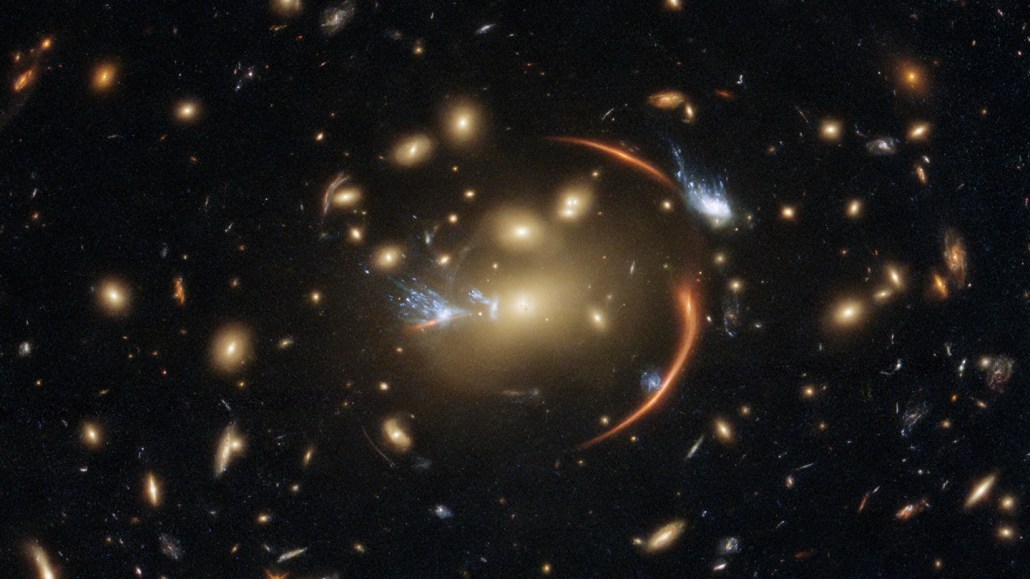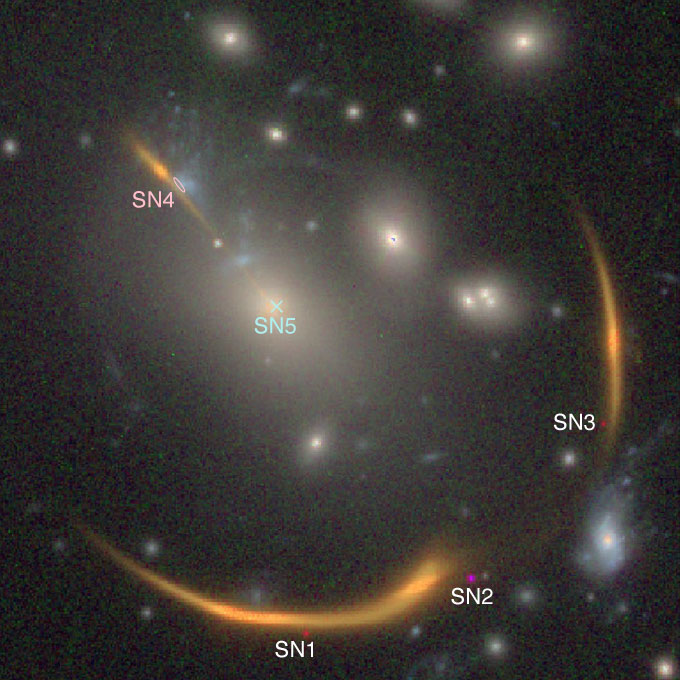
This cluster of galaxies, seen in a Hubble telescope image, contorts the light of a galaxy far behind it into arcs (orange).
A. Newman, M. Akhshik, K. Whitaker, Hubble/NASA, ESA
A meandering trek taken by light from a remote supernova in the constellation Cetus may help researchers pin down how fast the universe expands — in another couple of decades.
About 10 billion years ago, a star exploded in a far-off galaxy named MRG-M0138. Some of the light from that explosion later encountered a gravitational lens, a cluster of galaxies whose gravity bent the light so that we see multiple images. In 2016, the supernova appeared in Earth’s sky as three distinct points of light, each marking three different paths the light took to get here.
Now, researchers predict that the supernova will appear again in the late 2030s. The time delay — the longest ever seen from a gravitationally lensed supernova — could provide a more precise estimate for the distance to the supernova’s host galaxy, the team reports September 13 in Nature Astronomy. And that, in turn, may let astronomers refine estimates of the Hubble constant, the parameter that describes how fast the universe expands.
The original three points of light appeared in images from the Hubble Space Telescope. “It was purely an accident,” says astronomer Steve Rodney of the University of South Carolina in Columbia. Three years later, when Hubble reobserved the galaxy, astronomer Gabriel Brammer at the University of Copenhagen discovered that all three points of light had vanished, indicating a supernova.
By calculating how the intervening cluster’s gravity alters the path the supernova’s light rays take, Rodney and his colleagues predict that the supernova will appear again in 2037, give or take a couple of years. Around that time, Hubble may burn up in the atmosphere, so Rodney’s team dubs the supernova “SN Requiem.”
“It’s a requiem for a dying star and a sort of elegy to the Hubble Space Telescope itself,” Rodney says. A fifth point of light, too faint to be seen, may also arrive around 2042, the team calculates.

The predicted 21-year time delay — from 2016 to 2037 — is a record for a supernova. In contrast, the first gravitational lens ever found — twin images of a quasar spotted in 1979 — has a time delay of only 1.1 years (SN: 11/10/1979).
Not everyone agrees with Rodney’s forecast. “It is very difficult to predict what the time delay will be,” says Rudolph Schild, an astrophysicist at the Harvard-Smithsonian Center for Astrophysics in Cambridge, Mass., who was the first to measure the double quasar’s time delay. The distribution of dark matter in the galaxy hosting the supernova and the cluster splitting the supernova’s light is so uncertain, Schild says, that the next image of SN Requiem could come outside the years Rodney’s team has specified.
In any case, when the supernova image does appear, “that would be a phenomenally precise measurement” of the time delay, says Patrick Kelly, an astronomer at the University of Minnesota in Minneapolis who was not involved with the new work. That’s because the uncertainty in the time delay will be tiny compared with the tremendous length of the time delay itself.
That delay, coupled with an accurate description of how light rays weave through the galaxy cluster, could affect the debate over the Hubble constant. Numerically, the Hubble constant is the speed a distant galaxy recedes from us divided by the distance to that galaxy. For a given galaxy with a known speed, a larger estimated distance therefore leads to a lower number for the Hubble constant.
This number was once in dispute by a factor of two. Today the range is much tighter, from 67 to 73 kilometers per second per megaparsec. But that spread still leaves the universe’s age uncertain. The frequently quoted age of 13.8 billion years corresponds to a Hubble constant of 67.4. But if the Hubble constant is higher, then the universe could be about a billion years younger.
The longer it takes for SN Requiem to reappear, the farther from Earth the host galaxy is — which means a lower Hubble constant and an older universe. So if the debate over the Hubble constant persists into the 2030s, the exact date the supernova springs back to life could help resolve the dispute and nail down a fundamental cosmological parameter.







